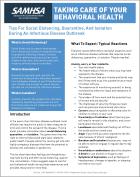This Advisory outlines how healthcare providers (i.e., obstetrician-gynecologists [OB-GYNs], primary care physicians, and other professionals who treat pregnant people) can take an active role in supporting the health of pregnant individuals who have OUD and their babies.
Dashboard: Filter Bricks
Main page content


The third supplemental to SAMHSA’s Clinical Guidance for Treating Pregnant and Parenting Women with Opioid Use Disorder and Their Infants publication. A compendium of resources for professionals who work with parents involved with child welfare.

This document accompanies the Clinical Guidance for Treating Pregnant and Parenting Women with Opioid Use Disorder and Their Infants publication. It offers information about child welfare systems and what the health care provider's role is in developing a Plan of Safe Care.

The fourth supplemental resource to SAMHSA’s Clinical Guidance for Treating Pregnant and Parenting Women with Opioid Use Disorder and Their Infants publication. This document contains information for pregnant people with a substance use disorder and preparing to deliver.

The National Guidelines for Child and Youth Behavioral Health Crisis Care offers best practices, implementation strategies, and practical guidance for the design and development of services that meet the needs of children, youth, and their families experiencing a behavioral health crisis. Additional technical guidance is provided in a companion report produced by SAMHSA in conjunction with the National Association of State Mental Health Program Directors, A Safe Place to Be: Crisis Stabilization Services and Other Supports for Children and Youth.

Parents and caregivers may not always understand and be able to identify behaviors in children and youth that are associated with adverse reactions to a disaster. This poster provides information on possible adverse reactions in children as well as where to get help.
¿Usted y su familia han sido afectados por un desastre?
Es posible que los padres y los cuidadores no siempre comprendan o no puedan identificar los comportamientos en niños y jóvenes que están relacionados con reacciones adversas a un acontecimiento catastrófico. Este póster ofrece información sobre las posibles reacciones adversas en los niños, así com.
Cov Tswv Yim Qhia Txog Kev Nyob Kom Sib Nrug Deb, Kev Caiv, Thiab Kev Nyob Ib Leeg Rau Thaum Muaj Tus Kab Mob Sib Kis
This tip sheet describes feelings and thoughts you may have during and after social distancing, quarantine, and isolation. It also suggests ways to care for your behavioral health during these experiences and provides resources for more help. HMONG Language Version.
This tip sheet describes feelings and thoughts you may have during and after social distancing, quarantine, and isolation. It also suggests ways to care for your behavioral health during these experiences and provides resources for more help. SOMALI Language Version.

This fact sheet explains social distancing, quarantine, and isolation in the event of an infectious disease outbreak. It discusses feelings and thoughts that may arise during this time and suggests ways to cope and support oneself during such an experience.

Have You and Your Family Been Affected by a Disaster? Poster pertaining to youth and child reactions
Parents and caregivers may not always understand and be able to identify behaviors in children and youth that are associated with adverse reactions to a disaster. This poster provides information on possible adverse reactions in children as well as where to get help.
Displaying 1 - 10 out of 16

